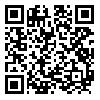GMJ Medicine
eISSN : 2626-3041
Volume 3, Issue 1 (2024)
GMJM 2024, 3(1): 1-5 |
Back to browse issues page
Article Type:
Subject:
History
Received: 2023/06/7 | Accepted: 2023/11/28 | Published: 2024/01/15
Received: 2023/06/7 | Accepted: 2023/11/28 | Published: 2024/01/15
How to cite this article
Saeidi M, Mohammadkhani Orouji F. Color, Rendering Index, and Medical Sciences. GMJM 2024; 3 (1) :1-5
URL: http://gmedicine.de/article-2-219-en.html
URL: http://gmedicine.de/article-2-219-en.html
Download citation:
BibTeX | RIS | EndNote | Medlars | ProCite | Reference Manager | RefWorks
Send citation to:



Rights and permissions
BibTeX | RIS | EndNote | Medlars | ProCite | Reference Manager | RefWorks
Send citation to:
Authors
M. Saeidi1, F. Mohammadkhani Orouji *2
1- Department of Psychology, Monireh Hospital of Medical Sciences, Tehran, Iran
2- Department of Psychology, Abarkouh Branch, Islamic Azad University, Abarkouh, Iran
2- Department of Psychology, Abarkouh Branch, Islamic Azad University, Abarkouh, Iran
Abstract (1124 Views)
Introduction: It has already been mentioned that the concept of "approximate color temperature" shows the spectral properties and color quality of light sources that produce a discontinuous spectrum. Although this concept provides good information about the intended sources, in many cases, it seems ineffective. It is important to note that what is meant is the effect of colors under the light of these sources in the eyes of the human observer, not the camera: the visual effect of colors is not meant to be their photographic effect. Two light sources of this type may have approximately the same color temperature, but the visual effect of the colors of objects under the light of these two light sources are different. As you can see, the Cool-White-Deluxe lamp produces more red light than the Cool-White lamp, which allows objects to be seen under the light of this red lamp.
Conclusion: Therefore, to have information about the visual appearance of objects under the light of such light sources (light sources with discontinuous spectrum), in addition to the concept of "approximate color temperature", we use another concept called "color reconstruction index".
Conclusion: Therefore, to have information about the visual appearance of objects under the light of such light sources (light sources with discontinuous spectrum), in addition to the concept of "approximate color temperature", we use another concept called "color reconstruction index".
| | Full-Text (HTML) (397 Views)
References
1. Majumder PK, Dasgupta S, Mukhopadhaya RK, Mazumdar UK, Gupta M. Anti-steroidogenic activity of the petroleum ether extract and fraction 5 (fatty acids) of carrot (Daucus carota L.) seeds in mouse ovary. J Ethnopharmacol. 1997;57(3):209-12. [Link] [DOI:10.1016/S0378-8741(97)00056-1]
2. Anwar MM, Meki AR. Oxidative stress in streptozotocin-induced diabetic rats: effects of garlic oil and melatonin. Comp Biochem Physiol. 2003;135(4):539-47. [Link] [DOI:10.1016/S1095-6433(03)00114-4]
3. Mani V, Kumar KG, Milind P. Antinociceptive and anti-inflammatory properties of daucus carota seeds extract. J Health Sci. 2006;52():598-606. [Link] [DOI:10.1248/jhs.52.598]
4. Marczewski K, Krawczyk W, Rozyc P, Raszewski G, Grzywna R, Klimek K. Day/night ratio of microproteinuria and blood pressure rhythm in type II diabetes. Diabetes Res Clin Pract. 1996;33(3):169-72. [Link] [DOI:10.1016/0168-8227(96)01276-4]
5. Masiello P, Broca C, Gross R, Roya M, Mantegehtti M, Hillaire-Buys D, et al. Experimental NIDDM: Development of a new model in adult rats administered streptozotocin and nicotinamide. Diabetes. 1998;47(2):224-9. [Link] [DOI:10.2337/diab.47.2.224]
6. Masuo K, Kawaguchi H, Mikami H, Ogihara T, Tuck ML. Serum Uric Acid and Plasma norepinephrine concentrations predict subsequent weight gain and blood pressure elevation. Hypertension. 2003;42(4):474-80. [Link] [DOI:10.1161/01.HYP.0000091371.53502.D3]
7. Meltzer AA, Everhart JE. Association between Diabetes and Elevated Serum Alanine Aminotransferase Activity among Mexican Americans. Am Epidemiol. 1997;146(7):565-71. [Link] [DOI:10.1093/oxfordjournals.aje.a009315]
8. Merzouk H, Madani S, Chabane D, Prost J, Bouchenak M, Belleville J. Time course of changes in serum glucose, insulin, lipids and tissue lipase activities in macrosomic offspring of rats with streptozotocin-induced diabetes. Clin Sci. 2000;98(1):21-30. [Link] [DOI:10.1042/cs0980021]
9. Yakes FM, Van Houten B. Mitochondrial DNA damage is more extensive and persists longer than nuclear DNA damage in human cells following oxidative stress. Proc Nat Acad Sci U S A. 1997;94(2):514-9. [Link] [DOI:10.1073/pnas.94.2.514]
10. Modan M, Hilkin H, Karasik A, Lusky A. Elevated serum uric acid--a facet of hyperinsulinaemia. Diabetologia. 1987;30(9):713-8. [Link] [DOI:10.1007/BF00296994]
11. Morel DW, Chisolm GM. Antioxidant treatment of diabetic rats inhibits lipoprotein oxidation and cytotoxicity.. J lipid Res. 1989;30(12):1827-34. [Link] [DOI:10.1016/S0022-2275(20)38196-7]
12. Mulec H, Blohme G, Gronde B, Bjorck S. The effect of metabolic control on rate of decline in renal function in insulin-dependent diabetes mellitus with overt diabetic nephropathy. Nephrol Dial Transplant. 1998;13(3):651-5. [Link] [DOI:10.1093/ndt/13.3.651]
13. Muralidharan P, Balamurugan G, Kumar P. Inotropic and cardioprotective effects of Daucus carota Linn. on isoproterenol-induced myocardial infarction. Bangladesh J Pharmacol. 2008;3(2):74-9. [Link] [DOI:10.3329/bjp.v3i2.849]
14. Nakanishi N, Okamoto M, Yoshida H, Matsuo Y, Suzuki K, Tatara K. Serum uric acid and risk for development of hypertension and impaired fasting glucose or Type II diabetes in Japanese male office workers. Eur J Epidemiol. 2003;18:523-30. [Link] [DOI:10.1023/A:1024600905574]
15. Navarro MC, Montilla MP, Martin M, Jimenez J, Utrilla MP. Free radical scavenger and antihepatotoxic activity of Rosmarinus tomentosus. Planta Med. 1993;59(4):312-4. [Link] [DOI:10.1055/s-2006-959688]
16. Neef N, Decleveq HN, Laekemen G. . Hypoglycaemic activity of selected European plants Phytother Res. 1995;9(1):45-8. [Link] [DOI:10.1002/ptr.2650090111]









